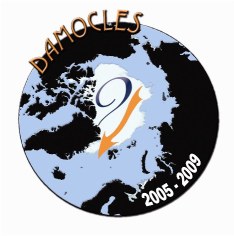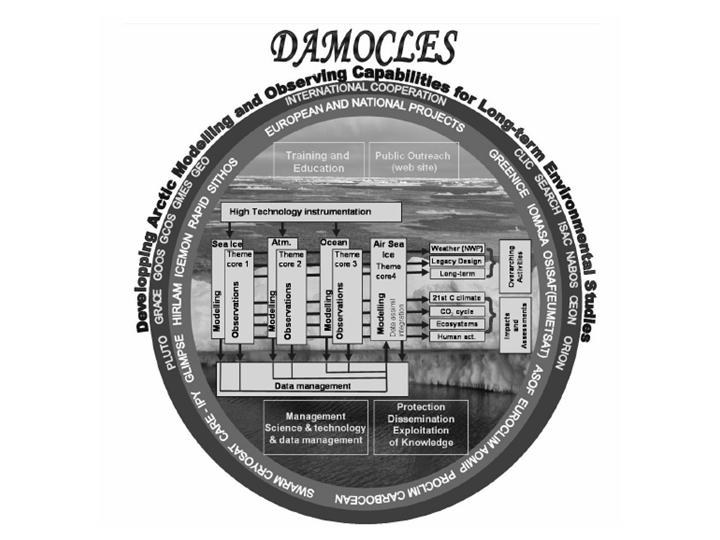DAMOCLES (2005-2010)
Objectives
The main objective of DAMOCLES is to reduce the uncertainties in our understanding of climate change in the Arctic and in the impacts thereof.
 To meet this objective DAMOCLES will, following the approach of Numerical Weather Prediction Centers, develop an integrated system for obtaining relevant geophysical observations, transferring them to a central databank, distributing them to the modelling centers, and producing nowcasts and forecasts of the Arctic climate. But since there exists no such thing as an Arctic Ocean Observing System, nor fully validated models for Arctic climate, nor accepted methods for forecasting of climate, a number of specific objectives need to be met in DAMOCLES:
To meet this objective DAMOCLES will, following the approach of Numerical Weather Prediction Centers, develop an integrated system for obtaining relevant geophysical observations, transferring them to a central databank, distributing them to the modelling centers, and producing nowcasts and forecasts of the Arctic climate. But since there exists no such thing as an Arctic Ocean Observing System, nor fully validated models for Arctic climate, nor accepted methods for forecasting of climate, a number of specific objectives need to be met in DAMOCLES:
-
Synoptic observational coverage of the Arctic Ocean sea-ice cover
The variability of sea-ice thickness, extent, concentration, ice-type and drift will be monitored by remote and in-situ systems in near real-time. Sea-ice dynamics and thermodynamics will be scrutinized to better understand their role for the largescale ice-atmosphere-ocean system. -
Synoptic observation and investigation of atmospheric key processes
Aimed at a better predictability of the Arctic weather and climate key processes are investigated in a combined observational/process-modelling effort: the effects of Arctic cyclone on sea-ice in terms of heat and moisture transport, an improvement of boundary-layer physics over ice and ocean, an improvement of the radiative transfers and its interaction with snow and sea- ice. - Synoptic observation of the Arctic Ocean circulation and key processes
An observational system will be set up with the aim to improve the understanding of the large-scale circulation of the Arctic Ocean and its vertical and lateral exchanges as well as the communication between central basins and the shelves. New techniques will be used to assess synoptically the state of the ocean under the ice and the fluxes of heat, salt and volume across the boundaries.
- Integration and assimilation of observations with large-scale models
Model sensitivities will be investigated and performance be improved by model-model and model-data comparison, aiming at an improved predictability. Observations will be enhanced by a set of assimilation activities to deliver reanalysed Arctic variables in time and space.
- Assessment of impact on environment and humans
To address the question of potential impacts of climate change in the Arctic the observationally supported model improvements, the model sensitivities and past ranges of variability will be combined with new field data. The aim is to evaluate improved predictability and its consequences, as well as the impact of projected changes on adaptation capabilities and vulnerability of the environment and human activities. -
User-friendly return of information to the community
DAMOCLES will not work in isolation – it serves the European community. Exploitation and dissemination of the results are key elements of the project. Therefore, a website will be available; giving the community updated information about the state of the Arctic (e.g. real-time information of key atmospheric, ice and ocean variables) as well as information about the progress of the science of DAMOCLES. Education will be provided, through workshops and student scholarships. Results will be published, both in scientific journals and in the popular-scientific press. The PIs will generally make themselves available to the public to the best of their ability.
The contribution of OASys to the DAMOCLES project consists of the setup and analysis of an adjoint code of the NAOSIM couples ice-ocean model and the performance of data assimilation …. In close cooperation with the FastOpt and the Alfred Wegener Institute for Polar and Marine Research.
DAMOCLES is funded under from 2006-2009 in the 6th Framework of the European Commission under Priority 1.1.6.3 “Global Change and Ecosystems”, see the Commission's own description of the DAMOCLES project here.
DAMOCLES is a european contribution to the International Polar Year 2007 - 2008.
Related References
-
Gerdes, R, Hurka, J, Karcher, M, Kauker, F, and Köberle, C (2005).
Simulated history of convection in the Greenland and Labrador seas 1948-2001
In: Climate Variability of the Nordic Seas. Bjerknes Centre for Climate Research, Bergen, Norway, Bjerknes Centre for Climate Research, Bergen, Norway. -
Harms, IH, and Karcher, MJ (2005).
Kara Sea freshwater dispersion and export in the late 1990s
J. Geophys. Res. 110(C08007). -
Karcher, M, Gerdes, R, Kauker, F, Köberle, C, and Yashayaev, I (2005).
Arctic Ocean change heralds North Atlantic freshening
Geophys. Res. Lett. 32(L21606). -
Kauker, F, Gerdes, R, Karcher, M, and Köberle, C (2005).
Impact of North Atlantic Current changes on the Nordic Seas and the Arctic Ocean
Journal of geophysical research 110(C12002). -
Polyakov, IV, Beszczynska, A, Carmack, EC, Dmitrenko, IA, Fahrbach, E, Frolov, IE, Gerdes, R, Hansen, E, Holfort, J, Johnson, VV, Karcher, M, Kauker, F, Morison, J, Orvik, KA, Schauer, U, Skagseth, HL, Sokolov, VT, Steele, M, Timokhov, LA, Walsh, D, and Walsh, JE (2005).
One more step toward a warmer Arctic
Geophys. Res. Lett. 32(L17605). -
Goose, H, Gerdes, R, Kauker, F, and Köberle, C (2004).
On the causes of sea-ice volume variations during the period 1955-1997
J. Climate 17(3):1294-1305. -
Gerdes, R, Karcher, MJ, Kauker, F, and Schauer, U (2003).
Causes and development of repeated Arctic Ocean warming events
Geophys. Res. Lett. 30(19). -
Karcher, MJ, Gerdes, R, Kauker, F, and Köberle, C (2003).
Arctic warming: Evolution and spreading of the 1990s warm event in the Nordic seas and the Arctic Ocean
J. Geophys. Res. 108(C2). -
Karcher, MJ, Kulakov, M, Pivovarov, S, Schauer, U, Kauker, F, and Schlitzer, R (2003).
Atlantic Water flow to the Kara Sea - comparing model results with observations
In: Siberian River Runoff in the Kara Sea: Characterisation, Quantification, Variability and Environmental Significance, edited by Stein and Fahl and Fütterer and Galimov. Elsevier, pages 47-69. -
Kauker, F, Gerdes, R, Karcher, M, Köberle, C, and Lieser, JL (2003).
Variability of Arctic and North Atlantic sea ice: A combined analysis of model results and observations from 1978 to 2001
J. Geophys. Res. 108(C6). -
Rinke, A, Gerdes, R, Dethloff, K, Kandlbinder, T, Karcher, M, Kauker, F, Frickenhaus, S, Köberle, C, and Hiller, W (2003).
A case study of the anomalous Arctic sea ice conditions during 1990: Insights from coupled and uncoupled regional climate model simulations
J. Geophys. Res. 108(D9). -
Karcher, MJ, and Oberhuber, JM (2002).
Pathways and modification of the upper and intermediate waters of the Arctic Ocean
J. Geophys. Res. 107(C6). -
Harms, IH, Karcher, MJ, and Dethleff, D (2000).
Modelling Siberian river runoff - implications for contaminant transport in the Arctic Ocean
Journal of Marine Systems 27:95-115. - Harms, IH, and Karcher, MJ (1999).
Modeling the seasonal variability of hydrography and circulation in the Kara Sea
J. Geophys. Res. 104:13431 - 13448.

